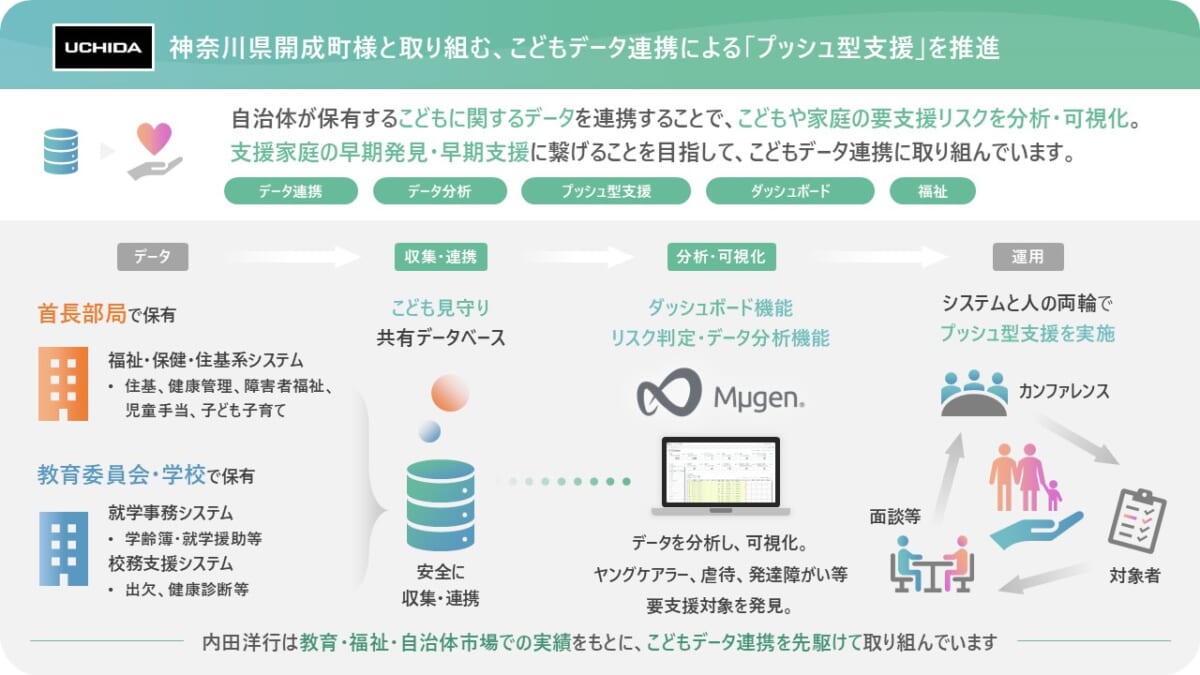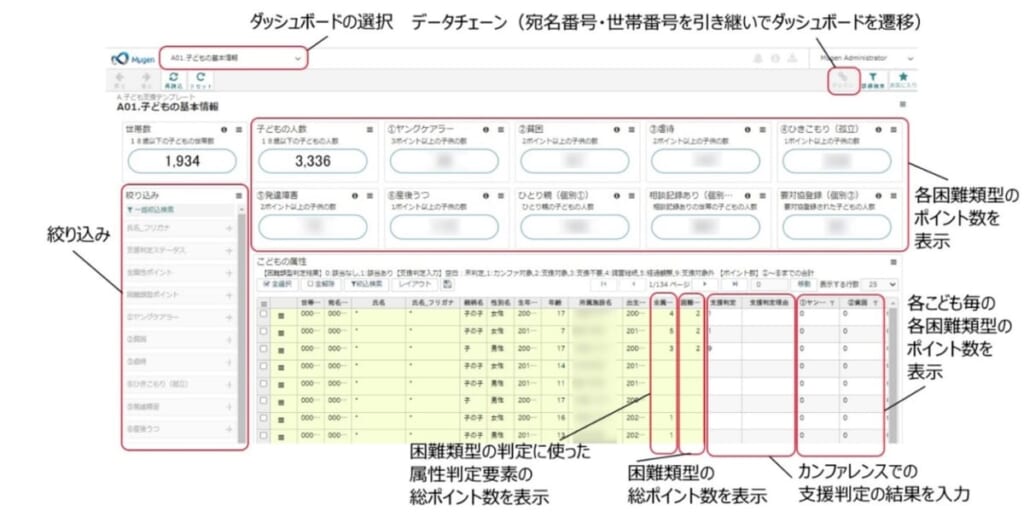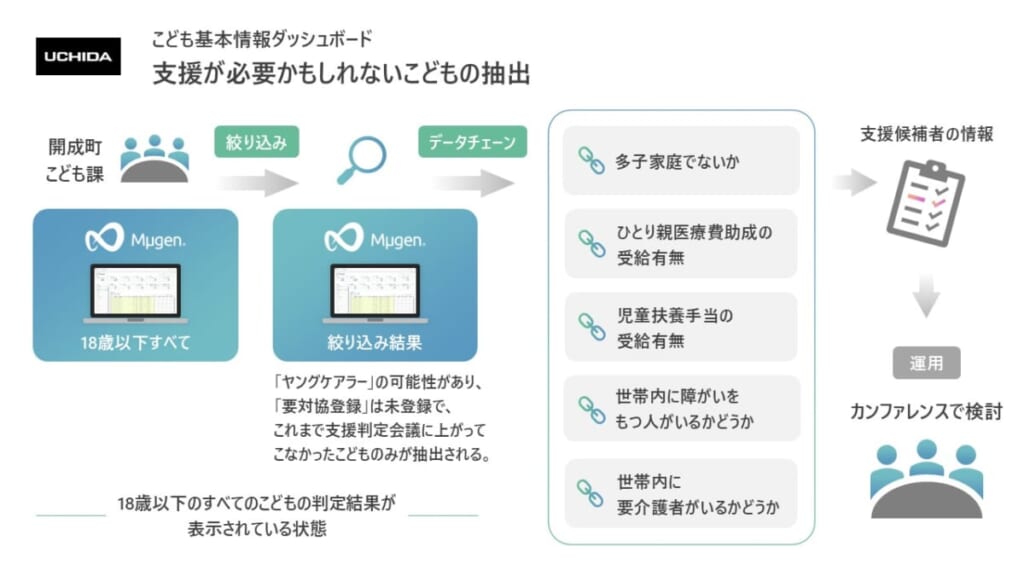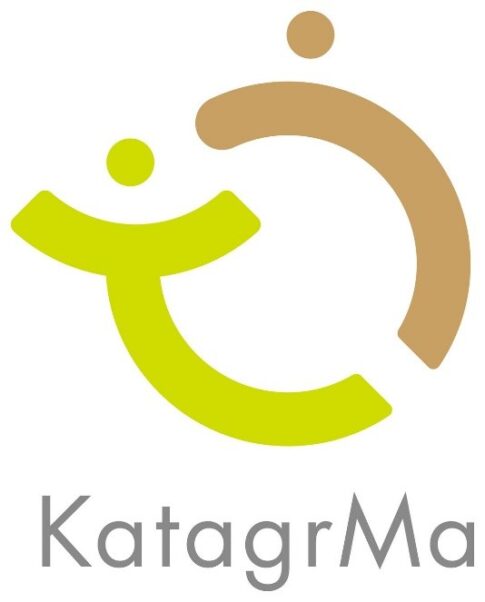~Early detection and early support for children and families in need of assistance by coordinating information on welfare and education
- The following is content from the press release -
(Headquarters: Chuo-ku, Tokyo; President: Noboru Okubo; hereinafter "Uchida Yoko") will start operating the "Kaisei-cho Child Watching System" in Kaisei-cho, Kanagawa Prefecture (Mayor: Yutaka Yamagami; hereinafter "Kaisei-cho") in May 2025 to realize early detection and early support of children and families in need of assistance by linking information on children held by the welfare and education departments. The "Kaisei-cho Child Watching System" will be put into operation in May 2025. This system was first tested in fiscal 2022 as part of the Kaisei Town's independent budgeted "Child Data Linkage and Utilization Research Project," and was selected for the "Child Data Linkage Demonstration Project" by the Child and Family Agency for two years in fiscal 2023 and 2024 (*1). The project has been put into operation as a result of step-by-step verification and system improvement.
(*1) Implementation status of the "Survey Project for Linkage and Utilization of Data on Children" in Kaisei Town
FY2022, FY2023, FY2024
In both fiscal years 2023 and 2024, the project was adopted as a demonstration project for the "Child Data Linkage Demonstration Project" of the Administration for Children and Families.

Kaisei Town Issues and System Development Objectives
Kaisei Town, the smallest town in Kanagawa Prefecture in terms of area, is conveniently located 90 minutes from Tokyo, and as a "rural modern" town with a rich natural environment and excellent child-rearing support, the ratio of the juvenile population to the total population was 14.8% in FY2020, the highest in the prefecture. Against this backdrop, the number of households with school-aged children moving into the area has increased, and the number of cases where there is no information on preschool age children has increased, making it difficult to ascertain background information on families. In addition, problems faced by children and families are becoming more complex, such as families in need of protection and support, information on high-risk pregnant women provided by maternity hospitals, and an increase in consultations and notifications concerning abuse. As a result, the workload of public health nurses and caseworkers has increased, and there has been a need to strengthen the support system.
On April 1, 2024, Kaisei Town established the "Child and Family Center," which integrates the maternal and child health function (Comprehensive Support Center for Child Rearing Generation) and the child welfare function (Comprehensive Support Center for Child and Family) within the Child Division, and established a comprehensive consultation support system for child rearing. By linking data on children scattered throughout the welfare and education departments and introducing the "Child Watching System," which determines, analyzes, and visualizes the risks of children and families in need of support, we aim for early detection and early support from the perspective of both the organizational structure and the system.
Features of the Kaisei Town Child Watching System
This system is operated by the staff of the Child Support Team of the Children's Division to identify and analyze children who may have difficulties from multiple perspectives. Approximately 40 types of data on children scattered throughout the welfare and education fields are collected and linked while taking personal information into consideration, and the data is analyzed and visualized based on indicators defined for each type of difficulty.
This system does not use a generative AI to extract support targets.

Examples of linked data items and linked systems
This system is linked to the following data (including some paper data)
Welfare, Health, and Residential Systems
- Children Division: Issuance of Maternal and Child Health Handbook / Pregnancy Checkups / Health Checkups / Utilization of Childcare and Education Benefits / Receipt of Child Allowance / Medical Expense Subsidies / Arrears (Daycare Center Fees, School Child Usage Fees) / Utilization of Childcare Support Center, etc.
- Measures for children in need of protection: Abuse notification status (paper) / Child consultation records (ACCESS) / Records of consultation for children in need of protection, etc.
- Welfare and Long-Term Care Division: Status of disability certificate/nursing care service use/receiving welfare benefits (paper), etc.
School enrollment administration system and school administration support system
- Board of Education and Schools: Schooling aid approval status (Excel)/ School age book/ Attendance status/ Health checkups, etc.
Main Functions of the "Child Watching System
(1) "Risk assessment and data analysis" functionality that leverages the know-how and expertise of professionals
In this system, risk indicators defined for each type of difficulty (young caregivers, poverty, abuse, withdrawal, developmental disabilities, postpartum depression, etc.) are set and scored for children aged 0 to 18. The scoring logic is formulated based on the knowledge of experts and professionals, and the DX analysis tool "Mµgen" (*2) is used to explore and visualize relevant data to make a comprehensive judgment on the need for support.
(*2) "Mµgen" supports more than 200 types of data sources, and can visualize related information by linking multiple dashboards while performing advanced data analysis of diverse systems scattered throughout the organization. The "data chain function" allows users to search and display different types of data in succession, allowing them to intuitively grasp the connection and flow of data. The system has been introduced to major companies in the manufacturing industry, including Toyota Motor Corporation, Honda R&D Labs, and Yamaha Motor, as well as in the healthcare field, including Chugai Pharmaceutical and Omron Healthcare.https://smartinsight.jp/

(2) "Dashboard function" designed with operability of on-site staff in mind
The dashboard function allows the user to grasp the overall situation, and to check the situation of children and families of concern on individual detailed screens. For example, the dashboard function narrows down potential candidates for support based on conditions such as, "There is a possibility that the child may be a young carer, but has not yet registered with the Regional Council on Children in Need of Aid and has not yet attended a support decision meeting," and then allows the user to check the applicable status of the decision factors for each household on the detailed screen. In this way, the dashboard function allows the user to grasp the overall situation and to check the status of children and families that may be suffering from specific difficulties. For example, the "Basic Information Dashboard for Children" allows you to identify potential candidates for support by narrowing down the list of children who may be "Young Carers" to those who are "not registered with the Regional Council on Measures for Children in Need of Protection" and "have not attended a support decision meeting". Furthermore, using the child's household number, you can move to the "Young Carer Judgment Details" dashboard and check the applicable status of each judgment factor in detail.
The system integrates multiple data and visualizes them on a single screen, and the operability to develop detailed data as needed allows for an intuitive and accurate grasp of the overall picture of individual children and families.

(3) Safety of the "Shared Database for Child Watching" (3) Safety of the "Shared Database for Child Watching
Strict access control is performed on the administrative network for the use of personal information numbers to ensure safe access to necessary information. In addition, the system is also equipped with a function to handle data in a form that does not identify individuals by applying a pseudonymization process (replacement by a sign, etc.) to information that can identify individuals, such as names and addresses.
Operation of support services using the "Kaisei Town Child Watching System" and monthly conferences
As a result of the judgment by the system, the extracted child is accepted as one of the child consultation, etc., and the need for support is discussed at a conference by public health nurses, caseworkers (social workers and mental health workers), and guidance counselors. Through conferences from a preventive perspective, we aim to build a support system in which education and welfare work together. In addition, all data collection and collaborative processing is completed in a system within the municipality, ensuring safe operation.
In the demonstration project in FY2024, information was updated about once a month using the data extraction function (EUC function) of each system, and watch-over based on the latest information, including information on transfers such as moving in and out. Based on the efforts made in the previous fiscal year, in FY2025, we will further study the system for watching over the residents for appropriate operation in the field.
Toward the future Initiatives to support standardization of municipal systems
Currently, among the mission-critical systems that are the source of data linkage, the welfare/health and school attendance administration systems, which are subject to unification and standardization of mission-critical systems in local governments, are being studied to facilitate their deployment to other municipalities by utilizing the data items specified in the standard specifications. In addition, Kaisei Town's "Child Watching System" is also being studied with a view to adapting it to the standard specifications.
Uchida Yoko's Initiatives Related to Children's Data Linkage, etc.
Uchida Yoko has developed and operated systems in the fields of education (schoolwork support systems, learning support systems, etc.), welfare (child welfare and welfare for the disabled), and local government (school attendance, internal office systems, etc.), and has a deep understanding of various types of operations, system configurations, and data structures. In addition to municipal systems, such as administrative systems that use the "My Number" and LGWAN connection systems, we also have extensive experience in network systems that cross different domains, such as schoolwork and learning systems. We are also actively involved in system standardization, and have been involved in the formulation and promotion of school attendance office systems (e.g., school age book compilation, etc.) and international technical standards. Using this knowledge, we are supporting the organization and analysis of resident information, abuse consultation records, attendance and health checkups, and other data handled in the education and welfare fields in Kaisei Town by understanding the characteristics of each data (meaning, type, frequency and timing of updates, etc.). We are working for the better growth of children in Kaisei-machi and the utilization of data throughout the region, while placing importance on the perspectives of both the local government and the educational field.
Uchida Yoko Children's Data Linkage Initiative
https://www.uchida.co.jp/public/data-linkage-for-children
■Collaboration and Utilization of Children's Data to Achieve Push-Based Support: Kaisei Town, Kanagawa Prefecture
https://www.uchida.co.jp/public/contents/report_250212.html














